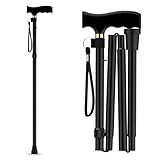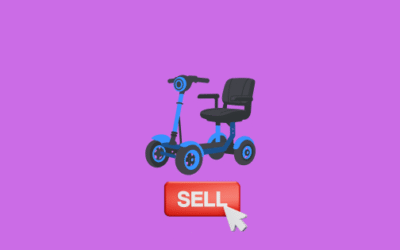Key Takeaways For Best Walking Sticks
Factors for Choosing Walking Sticks: Stability is crucial for balance and fall prevention. Grip comfort and height adjustability enhance usability. Consider weight, tip design, and foldability/portability.
Traditional Walking Sticks: Timeless blend of style and practical support. Versatile, suits occasional to permanent use. They were crafted from quality materials for aesthetics and reliability.
Folding Walking Sticks: These are portable and convenient for on-the-go users. Their foldable design makes them easy to store and transport. Quality is considered to ensure stability during use.
Top Walking Sticks
Selecting the right walking stick is crucial for individuals with mobility challenges, as it can greatly enhance stability, balance, and overall mobility. Whether you need support due to injury, illness, or age-related conditions, finding the right walking stick tailored to your needs is essential. Stability, grip comfort, height adjustability, and the intended usage environment are crucial in determining the ideal walking stick. In this guide, we will explore these factors in detail, providing valuable insights and guidance to help you make an informed choice, allowing you to regain confidence and independence in your daily activities.
Factors to Consider When Selecting a Walking Stick
When choosing a walking stick, it’s important to consider several factors to ensure it meets your needs and provides the support and stability you require. Here are key factors to keep in mind:
- Stability: Look for a walking stick with excellent stability. This will help you maintain balance and reduce the risk of falls. Sturdy construction and a secure base are essential for optimal strength.
- Grip Comfort: Consider the grip of the walking stick. It should be comfortable to hold and provide a secure grip to prevent slipping. Options range from traditional handles to ergonomic designs or contoured grips.
- Height Adjustability: Opt for a walking stick with height adjustability to ensure it can be customised to your specific height requirements. This allows for proper posture and reduces strain on your joints.
- Weight: Consider the weight of the walking stick. A lightweight stick is generally more manageable and easier to carry, especially if you need to use it for an extended period or during travel.
- Tip Design: The tip of the walking stick should suit the intended usage environment. Rubber tips are ideal for indoor use, while spiked or broader tips provide better traction on uneven terrain or outdoor surfaces.
- Foldability and Portability: If you need a walking stick that can be easily transported or stored, consider a foldable or collapsible design. These types of walking sticks are convenient for travel or when space is limited.
- Style and Aesthetics: While not directly related to functionality, the walking stick’s style and aesthetics can contribute to your overall satisfaction and confidence. Choose a design that resonates with your taste and makes you feel comfortable and confident while using it.
- Professional Guidance: If you have specific mobility needs or health concerns, it’s advisable to consult with a healthcare professional or mobility specialist who can provide expert advice and recommendations tailored to your situation.
Considering these factors, you can make an informed decision when selecting a walking stick that suits your mobility needs. Finding the right walking stick can greatly improve your stability, confidence, and overall quality of life.
Traditional Walking Sticks: Classic Style and Functionality
Traditional walking sticks have stood the test of time, offering a blend of classic style and practical support for individuals seeking a timeless mobility aid. These walking sticks often feature elegant designs crafted from high-quality materials such as wood or metal, making them aesthetically pleasing and reliable companions.
One of traditional walking sticks’ key advantages is their versatility. They suit many users, from those requiring occasional support to individuals with more permanent mobility challenges. Conventional walking sticks are available in various lengths and styles, allowing customisation to suit individual heights and preferences.
Using natural materials, such as hardwoods or bamboo, lends a touch of elegance and sophistication to traditional walking sticks. Some designs showcase exquisite carvings or ornamental details, adding to their visual appeal. The tactile nature of these materials provides a comfortable grip and a sense of connection with the stick, enhancing the overall user experience.
Beyond their aesthetic appeal, traditional walking sticks offer practical functionality. They provide stability and support, assisting users in maintaining balance while walking. Traditional sticks typically feature a rubber or metal tip at the bottom, providing traction and stability on different surfaces.
Traditional options offer a wide array of choices for those seeking a walking stick that blends seamlessly with their attire. A conventional walking stick suits every style and occasion, from sleek and minimalist designs to intricately decorated handles or shafts.
It’s important to note that traditional walking sticks may offer different adjustability and advanced features than some modern alternatives. However, their simplicity and reliability make them popular among individuals who appreciate a classic look and straightforward functionality.
Whether strolling through the park, attending a formal event, or simply navigating everyday activities, a traditional walking stick can be a reliable and stylish companion. Its timeless appeal and practical support make it an enduring option for those seeking a touch of elegance and functionality in their mobility aid.
Folding Walking Sticks: Convenient and Portable Options
Folding walking sticks have become a practical and portable choice for individuals seeking a versatile mobility aid. These walking sticks offer the convenience of compactness, allowing for easy storage and transportation when not in use. Their foldable design makes them ideal for individuals who are frequently on the go or require a walking aid that can be easily stowed away.
The primary advantage of folding walking sticks is their portability. They can be effortlessly folded into a compact size, making them easy to carry in a bag, purse, or luggage. This feature particularly benefits travellers or individuals needing intermittent assistance throughout the day.
Despite their foldable nature, these walking sticks are engineered to provide reliable support and stability. They are constructed with durable materials, such as lightweight aluminium or carbon fibre, ensuring strength and durability without compromising functionality.
Another notable characteristic of folding walking sticks is their adjustable height feature. Most models offer telescopic shafts that can be extended or retracted to accommodate individual height requirements. This allows for a personalised fit, promoting proper posture and reducing strain on the body.
Folding walking sticks often come with additional features designed to enhance usability. These may include ergonomic handles for a comfortable grip, wrist straps for added security, and non-slip rubber tips for improved traction on various surfaces.
The versatility of folding walking sticks makes them suitable for many users. Whether you need temporary support during recovery, travelling assistance, or a reliable everyday mobility aid, folding walking sticks provide a practical and convenient solution.
While folding walking sticks offer compactness and convenience, they may not provide the same level of stability as non-foldable options. Choosing a high-quality folding walking stick that is sturdy and secure when extended is important, ensuring your safety and comfort during use.
In conclusion, folding walking sticks are an excellent choice for those seeking portable and convenient walking aids. Their collapsible design, adjustable height, and practical features make them a versatile option for individuals who value mobility and ease of use. With a folding walking stick, you can confidently navigate your daily activities with added support and flexibility.
Adjustable Walking Sticks: Finding the Perfect Height for Comfort
Adjustable walking sticks offer a customisable solution for individuals seeking a walking aid tailored to their height requirements. These versatile mobility aids allow for easy adjustment, ensuring optimal comfort and stability.
One key advantage of adjustable walking sticks is their ability to accommodate individuals of varying heights. Whether you are tall or short, adjusting the height of the walking stick is crucial for maintaining proper posture and reducing strain on your joints.
The adjustability feature typically involves telescopic shafts with multiple height settings. This allows you to extend or retract the walking stick to find the perfect height that meets your needs. Many adjustable walking sticks also feature marked height indicators, making setting and maintaining your desired height easy.
Finding the right height for your walking stick is essential for optimal support and balance. Properly adjusting the walking stick should allow your elbow to bend comfortably, promoting a natural walking motion. It should neither be too high, causing you to lean or strain, nor too low, compromising your stability.
In addition to height adjustment, many adjustable walking sticks offer other features to enhance comfort and usability. Ergonomic handles provide a comfortable grip, reducing hand fatigue and increasing overall support. Some models also feature shock-absorbing mechanisms or anti-slip rubber tips for added stability and safety on various surfaces.
Adjustable walking sticks are suitable for many individuals, including those recovering from injuries, dealing with chronic conditions, or requiring temporary support. They are also beneficial for individuals who may experience changes in height or mobility over time, as the walking stick can be easily readjusted to accommodate these changes.
When selecting an adjustable walking stick, it is important to choose a high-quality model with durability and stability. Look for sturdy materials, secure locking mechanisms, and smooth height adjustment functionality. Consulting with a healthcare professional or mobility specialist can also provide valuable guidance in selecting the most suitable walking stick.
In conclusion, adjustable walking sticks provide a flexible and personalised solution for individuals seeking comfort, stability, and proper alignment. By finding the perfect height for your walking stick, you can enhance your mobility, reduce strain on your body, and confidently navigate your daily activities with greater ease.
Ergonomic Walking Sticks: Enhanced Grip and Support for Optimal Stability
Ergonomic walking sticks are designed to provide enhanced grip and support to promote optimal stability during use. These walking aids prioritise user comfort and ergonomics, offering a secure and comfortable grip for individuals seeking reliable help while walking.
One key feature of ergonomic walking sticks is the design of their handles. They are crafted with contoured shapes and materials that conform to the natural shape of the hand, reducing strain and discomfort. Ergonomic handles often feature soft padding or textured surfaces, providing a non-slip grip that enhances control and stability.
The ergonomic design of these walking sticks helps distribute pressure evenly across the hand and wrist, minimising the risk of developing blisters, calluses, or hand fatigue. By promoting proper hand positioning, ergonomic handles allow for a more relaxed and natural walking motion, reducing the strain on joints and muscles.
In addition to ergonomic handles, these walking sticks often incorporate other features to enhance stability and usability. Many models include straps that securely fasten around the wrist, preventing accidental drops and providing additional support. Some ergonomic walking sticks also have adjustable height settings to accommodate individual preferences and ensure proper posture.
The materials used in ergonomic walking sticks are carefully chosen for their durability and comfort. Common materials include lightweight metals like aluminium or carbon fibre, which offer strength without adding unnecessary weight. This makes ergonomic walking sticks easy to manoeuvre and carry for extended periods.
Ergonomic walking sticks suit many individuals with arthritis, joint pain, or grip strength limitations. They provide reliable support and stability, allowing users to confidently navigate different terrains and surfaces.
When selecting an ergonomic walking stick, consider factors such as handle design, material quality, and overall construction. Trying out different models and consulting with healthcare professionals or mobility specialists can help determine the most suitable option for your needs.
In conclusion, ergonomic walking sticks offer an enhanced grip and support system that prioritises user comfort and stability. By incorporating ergonomic handle designs and thoughtful features, these walking sticks provide an optimal walking experience, reducing strain and promoting confidence in daily mobility.
Walking Sticks with Built-in Accessories: Practical Features for Added Convenience
Walking sticks with built-in accessories are designed to offer practical features that enhance convenience and versatility for individuals who require mobility support. These innovative walking sticks go beyond the traditional functionality, incorporating additional accessories that cater to various needs and situations.
One key advantage of walking sticks with built-in accessories is their convenience. These sticks often feature integrated accessories such as LED lights, which improve visibility in low-light conditions or during nighttime walks. Some models may also include built-in seating options, enabling users to rest whenever needed without carrying an additional chair or stool.
Another popular accessory found in these walking sticks is a built-in storage compartment. This provides a convenient space to store small items like keys, medication, or personal belongings, eliminating the need for a separate bag or pocket. This feature is particularly useful for individuals who want to keep their essentials easily accessible while on the move.
Some walking sticks with built-in accessories may include attachments such as a built-in compass, thermometer, or whistle for added safety and convenience during outdoor activities or emergencies. These practical features can be invaluable when navigating unfamiliar environments or seeking assistance.
The materials used in these walking sticks are typically lightweight yet durable, ensuring they can withstand regular use while remaining easy to handle. The accessories are thoughtfully integrated into the design, maintaining the overall balance and stability of the walking stick.
Walking sticks with built-in accessories are suitable for many individuals, including those who enjoy outdoor activities, need additional support during travels, or value the convenience of readily available essential tools. These innovative walking sticks offer a multi-functional solution that combines mobility support with practical features.
When choosing a walking stick with built-in accessories, consider your specific needs and preferences. Assess the functionality of the included accessories and ensure they align with your requirements. Also, consider the overall quality and reliability of the walking stick, as well as its comfort and stability during use.
In conclusion, walking sticks with built-in accessories provide practical features that add convenience and versatility to your mobility aid. These walking sticks offer added functionality and comfort by incorporating accessories like LED lights, storage compartments, or additional tools, making them valuable companions for various activities and situations.
Lightweight Walking Sticks: Easy to Carry and Maneuver
Lightweight walking sticks are designed to provide individuals with a mobility aid that is easy to carry and manoeuvre without compromising strength or stability. These walking sticks prioritise portability, making them ideal for individuals who require a lightweight and convenient solution for their mobility needs.
One key advantage of lightweight walking sticks is their ease of carrying. They are crafted using lightweight materials such as aluminium or carbon fibre, significantly reducing the stick’s overall weight. This makes it effortless to transport the stick during daily activities or while travelling without causing undue strain or fatigue.
The lightweight nature of these walking sticks also contributes to their manoeuvrability. Users can lift and position the stick for each step, allowing smooth and controlled movements. This is particularly beneficial for individuals with limited strength or mobility, as the reduced weight of the stick minimises the effort required to use it effectively.
Despite their lightweight construction, these walking sticks are engineered to provide reliable support and stability. They are designed with a focus on strength and durability, ensuring they can withstand regular use and provide the necessary assistance. Many lightweight walking sticks also feature adjustable height settings, allowing for a customised fit that promotes proper posture and comfort.
The compact design of lightweight walking sticks further adds to their convenience. They can be easily folded or disassembled into smaller pieces, making them space-efficient for storage and transportation. This is especially advantageous for individuals who need to pack the walking stick in a bag or suitcase when on the go.
Lightweight walking sticks suit many individuals, including those recovering from injuries, older adults, or individuals with temporary or permanent mobility challenges. They provide a reliable, easy-to-use solution promoting independence and confidence in daily activities.
When selecting a lightweight walking stick, consider factors such as material quality, stability, and adjustability. Testing different models and consulting with healthcare professionals or mobility specialists can help determine the most suitable walking stick for your specific needs and preferences.
In conclusion, lightweight walking sticks offer a portable and manoeuvrable solution for individuals seeking a mobility aid that is easy to carry and use. Their lightweight construction, combined with strength and stability, ensures users can confidently navigate their daily routines while minimising physical strain. With a light walking stick, you can enjoy the benefits of enhanced mobility and independence.
Walking Sticks for Outdoor Activities: Exploring Nature with Confidence
Walking sticks designed for outdoor activities are the perfect companion for individuals who enjoy exploring nature and engaging in outdoor adventures. These specialised walking sticks are crafted with features that enhance stability, durability, and versatility, allowing outdoor enthusiasts to navigate uneven terrain and challenging environments confidently.
One key advantage of walking sticks for outdoor activities is their ability to provide enhanced stability. They are designed with rugged materials such as durable aluminium or carbon fibre, which offer strength and resilience to withstand the demands of outdoor use. This ensures users can rely on their walking stick for support on various terrains, including rocky paths, muddy trails, or steep inclines.
Outdoor walking sticks often feature robust tip designs that provide excellent traction and grip on different surfaces. Some models have spiked or rubber tips that stabilise slippery or uneven terrain. These features enable users to maintain balance and confidence during outdoor activities.
Furthermore, many walking sticks for outdoor use come with additional accessories and features tailored for outdoor enthusiasts. These may include built-in compasses, thermometers, or detachable camera mounts that allow users to capture their adventures hands-free. Some models even offer integrated shock-absorbing mechanisms to minimise joint impact during long hikes or intense activities.
Adjustability is another essential aspect of outdoor walking sticks. Most models offer adjustable height settings, allowing users to customise the stick’s length to suit their comfort and requirements. This ensures proper posture, reduces strain on the body, and promotes a more natural walking motion.
Walking sticks for outdoor activities are suitable for hikers, trekkers, backpackers, and anyone who enjoys exploring the great outdoors. They provide stability, support, and confidence, allowing individuals to tackle challenging terrains and fully immerse themselves in nature’s beauty.
When choosing a walking stick for outdoor activities, consider factors such as weight, durability, grip, and versatility. Look for models with a comfortable grip, reliable stability, and adjustable features to meet your specific needs and preferences. Consulting with outdoor experts or experienced hikers can provide valuable insights into selecting the most suitable walking stick for outdoor adventures.
In conclusion, walking sticks designed for outdoor activities are essential tools for nature enthusiasts seeking stability and confidence during their outdoor pursuits. With their sturdy construction, specialised features, and reliable grip, these walking sticks empower individuals to explore nature’s wonders with greater ease and enjoyment. So, grab your walking stick and confidently embark on your outdoor adventure!
Making the Right Choice for Your Walking Stick
Choosing the right walking stick is an important decision that can greatly impact your mobility, comfort, and overall well-being. By considering your specific needs, preferences, and intended use, you can make an informed decision that suits you best.
First and foremost, assess your mobility needs and determine the level of support you require. A traditional walking stick or cane may suffice if you need minimal help for balance and stability. For individuals with more significant mobility challenges, options such as forearm crutches or walking frames may provide the necessary assistance.
Consider the features that are most important to you. Are you looking for a lightweight and portable walking stick for easy transportation? Do you require additional accessories or specialised features for outdoor activities? Identifying your priorities will help narrow your choices and find the walking stick that meets your requirements.
Comfort is another crucial aspect to consider. Look for walking sticks with ergonomic handles that provide a comfortable grip and reduce strain on your hands and wrists. Adjustable height settings can ensure a proper fit, allowing for optimal posture and reduced stress on your body.
Durability and stability are vital factors when choosing a walking stick. Opt for high-quality materials that can withstand regular use and provide reliable support. Non-slip tips or attachments can enhance stability and prevent accidents, particularly on slippery or uneven surfaces.
Seek advice from healthcare professionals, mobility specialists, or experienced users. They can provide valuable insights and guidance based on their expertise or personal experiences. Testing different models and trying out various styles can also help you determine which walking stick feels the most comfortable and suits your needs.
Ultimately, the right walking stick should be a tool that empowers you, enhances your mobility, and improves your overall quality of life. It should provide the support, stability, and functionality you require, allowing you to navigate your daily activities with confidence and independence.
Remember, choosing a walking stick is a personal decision, and what works for one person may not work for another. Take your time, explore different options, and make an informed choice that aligns with your needs and preferences. With the right walking stick by your side, you can enjoy improved mobility, increased confidence, and a greater sense of freedom in your everyday life.
Frequently Asked Questions About Walking Sticks:
What is the purpose of using a walking stick?
Walking sticks are primarily used for providing stability, balance, and support while walking. They can be helpful for individuals with mobility issues, joint pain, or those who need assistance during long walks or hikes.
What are the different types of walking sticks available?
Several walking sticks are available, including traditional wooden sticks, collapsible walking sticks made from aluminium or carbon fibre, hiking poles designed for outdoor activities, and adjustable walking sticks with ergonomic handles.
How do I choose the right height for a walking stick?
To determine the appropriate height for a walking stick, stand up straight with your arms relaxed at your sides. The top of the walking stick should align with the crease of your wrist, allowing your elbow to bend comfortably at a slight angle when you hold the stick.
Can walking sticks be adjusted for different heights?
Yes, many walking sticks come with adjustable features. They often have telescopic shafts or multiple height settings, allowing you to customise the length according to your preference or changing needs.
What are the benefits of using a collapsible walking stick?
Collapsible walking sticks are convenient for travel and storage. They can be folded to a compact size, making them easy to pack in a suitcase or store in a bag when not in use.
Are there walking sticks available with ergonomic handles?
Many walking sticks feature ergonomic handles designed to provide a comfortable grip and reduce strain on the hand and wrist. These handles may have contoured shapes, cushioning, or unique materials for enhanced comfort.
How should I maintain and care for my walking stick?
To maintain your walking stick, wipe it clean after each use, especially if it comes into contact with dirt or moisture. If you have a wooden walking stick, you can apply a protective finish to prevent damage. For collapsible or adjustable walking sticks, periodically check the joints and locking mechanisms to ensure they function correctly.
Can people of all ages use walking sticks?
Yes, walking sticks can be used by people of various ages, depending on their needs. Older adults commonly use them to aid in balance and mobility. Still, they can also be helpful for individuals recovering from injuries or surgeries, people with certain medical conditions, or anyone who wants extra support during walks or hikes.
Best Selling Walking Sticks
Explore More Walking Aids and Mobility Solutions
- Best Walking Aids – Discover a variety of walking aids designed to improve stability and mobility.
- Best Walking Frames – Learn about walking frames that provide extra support and stability while walking.
- Best Rollators – Explore rollators that offer both walking support and convenience with a built-in seat.
- Best Tri-Walkers – Find tri-walkers that provide enhanced stability and are easy to maneuver.












